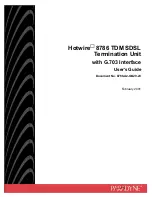
C H A P T E R 4 F E A T U R E S
V100 Versatile Multiplexer Technical Manual Version 2.2
Page 166 of 231
4.12.1
SWITCHED Mode
In this mode the V100 Aggregate port is connected to a switched service such as an Inmarsat-B terminal,
where the link is inactive and the V100 has no carrier with the remote unit until the ISDN link is
established. The modem needs to be told when to establish carrier by the mux and this will happen when
stimulated by a tributary port being activated. For example, when a telephone call is made from a channel
on the mobile unit, link bandwidth is required. This causes the aggregate port to raise the “C” or “RTS”
signal, which causes the Inmarsat terminal to request service. When the ISDN link is established, the
Receiver Ready (RR) signal from the terminal indicates that the connection may proceed, the V100s
establish carrier, a call setup packet is sent to the hub unit and the user hears dialtone from the PABX.
The call proceeds in the normal way until cleared, either by the mobile V100, which drops the “RTS” signal
to the terminal when the handset is replaced or by the hub V100 which clears the ISDN call when the line
is dropped by the PABX. In both cases the “RR” signal is dropped by the terminal and carrier is lost.
To configure the V100 to operate in this way, the aggregate port connected to the Inmarsat terminal must
be configured with the word “SWITCHED” entered in the destination field. In addition, the “Connection
Timeout” and “Receive Ready Filter” fields on the SYSTEM SETTINGS page become relevant. When an
Inmarsat terminal establishes carrier, the RR signal can be unstable until the link is securely established.
The Receive Ready Filter ensures that the V100 waits for the signal to stabilise before sending its first
packet. The ISDN system connection time can be quite long (up to 30 seconds is quite common on
















































